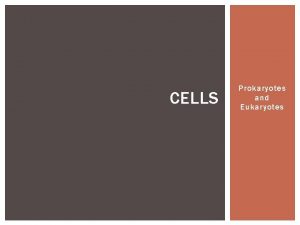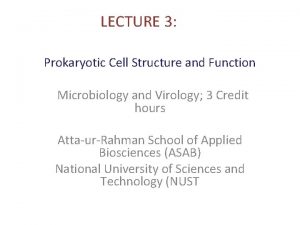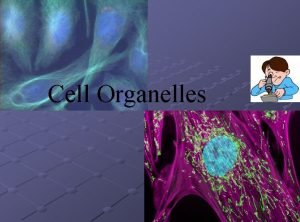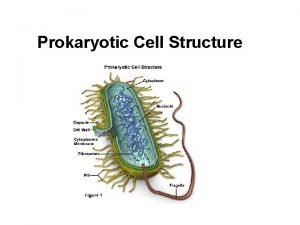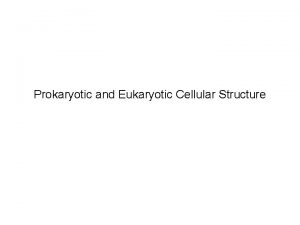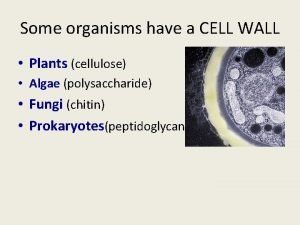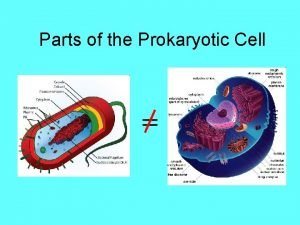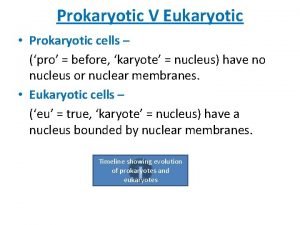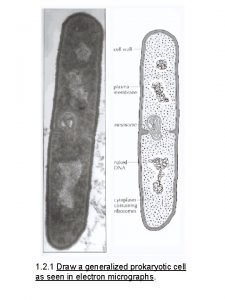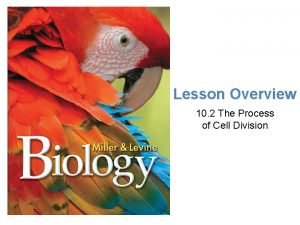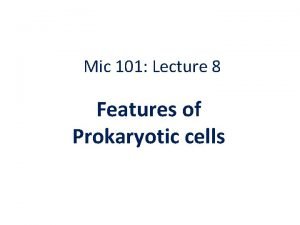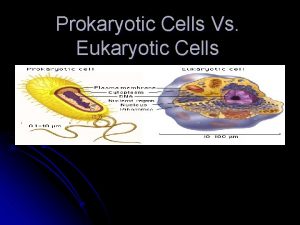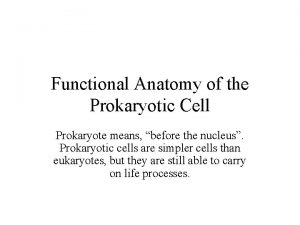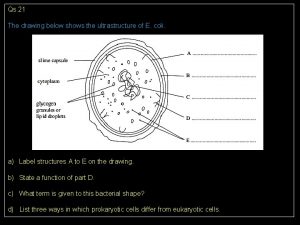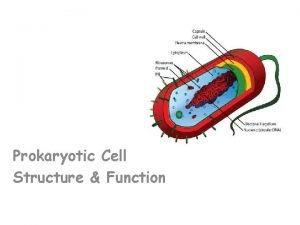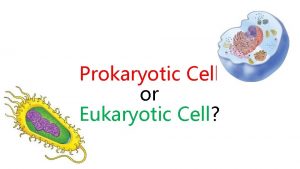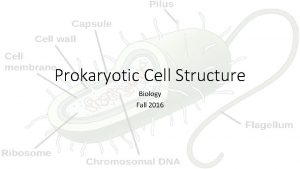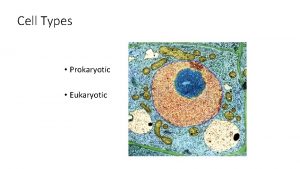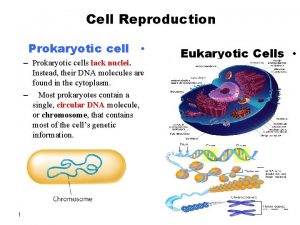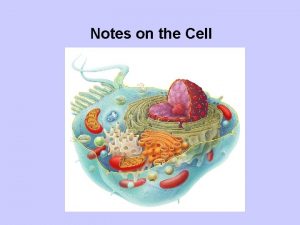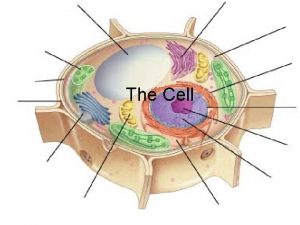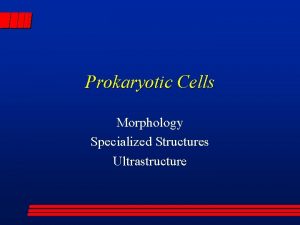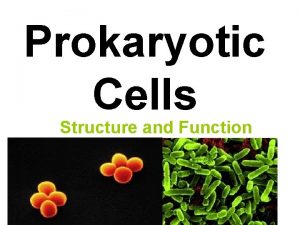A Tour of the Cell Coach Lott Prokaryotic































- Slides: 31

A Tour of the Cell Coach Lott

Prokaryotic cells are structurally simpler than eukaryotic cells A. All living organisms can be separated into two categories base on cell type, prokaryotic cells and eukaryotic cells. Common features of all cells are a plasma membrane, DNA, and ribosomes. The two groups of prokaryotic cells are the Bacteria and the Archaea. B. Prokaryotic cells are usually relatively small (1– 10 mm in length). C. Prokaryotic cells lack a nucleus: DNA is in direct contact with cytoplasm and is coiled into a nucleoid region. Eukaryotic cells have a true membrane-bound nucleus. D. Cytoplasm includes ribosomes (protein factories) suspended in a semi-fluid. E. Prokaryotic cells are otherwise composed of a bounding plasma membrane, complex outer cell wall (a rigid container, often with a sticky outer coat called a capsule), pili, and, sometimes, flagella.


Eukaryotic cells are partitioned into functional compartments A. Eukaryotic cells are usually relatively larger (10– 100 mm or more) in diameter. B. These cells are internally complex, with organelles of two types: membranous and non-membranous. C. Membranous organelles found in eukaryotic cells include the nucleus, endoplasmic reticulum, Golgi apparatus, mitochondria, lysosomes, and peroxisomes. D. Non-membranous organelles found in eukaryotic cells include ribosomes, microtubules, centrioles, flagella, and the cytoskeleton. E. Organelles serve two major functions, to compartmentalize cellular metabolism and to increase the membrane surface area for membranebound biochemical reactions.

Cont. F. Animal cells are bounded by the plasma membrane alone, often have flagella, and lack a cell wall. G. Plant cells are bounded by both a plasma membrane and a rigid cell wall composed of cellulose. In addition, plant cells usually have a central vacuole and chloroplasts, lack centrioles, and usually lack lysosomes and flagella. H. Cells of eukaryotes in other kingdoms vary in structure and components.


The nucleus is the cell’s genetic control center. A. The nuclear envelope is a double membrane, perforated with pores through which material can pass into and out of the nucleus, which separates this organelle from the cytoplasm. B. DNA can be seen as strands of chromatin dispersed inside the nucleus. Each strand of chromatin constitutes a chromosome. Prior to cell division, DNA is duplicated. C. During cell division, chromosomes coil up and become visible through a light microscope. D. The nucleolus, also within the nucleus, is composed of chromatin, RNA, and protein. The function of nucleoli is the manufacture of ribosomes. E. Besides the storage of heritable material, the nucleus synthesizes messenger RNA that leaves the cell and directs the synthesis of proteins at ribosomes


Many cell organelles are connected through the endomembrane system. A. An extensive system of membranous organelles, referred to as the endomembrane system, work together in the synthesis, storage, and export of molecules. B. Each of these organelles is bounded by a single membrane. Some are in the form of flattened sacs; some are rounded sacs; and some are tube-shaped. C. The major function of the endomembrane system is to divide the cell into separate compartments.


Smooth endoplasmic reticulum has a variety of functions A. The smooth endoplasmic reticulum, or smooth ER, is a series of interconnected tubes that lacks surface ribosomes. B. One job of smooth ER is to synthesize lipids. C. In other forms of smooth ER, enzymes help process materials as they are transported from one place to another. An example of this function is the detoxification of drugs by smooth ER in liver cells. D. A third function of smooth ER is the storage of calcium ions that are required for muscle contraction.


Rough endoplasmic reticulum makes membrane and proteins A. Rough endoplasmic reticulum (rough ER) is composed of flattened sacs that often extend throughout the entire cytoplasm. The rough ER has three functions: synthesis, modification, and packaging of proteins. B. Ribosomes on rough ER make proteins, some of which are incorporated into the membrane. Other proteins are packaged in membranous sacs that bud off the rough ER and are transported to the Golgi apparatus.


The Golgi apparatus finishes, sorts, and ships cell products. A. Transport vesicles from the ER fuse on one end of a Golgi apparatus to form flattened sacs. B. These sacs move through the stack like a pile of pancakes added at one end and eaten from the other. Molecular processing occurs in the sacs as they move through the Golgi. C. At the far end, modified molecules are released in transport vesicles.


Lysosomes are digestive compartments within a cell A. Lysosomes are one kind of vesicle produced at the far end of the Golgi. B. Lysosome vesicles contain hydrolytic enzymes that break down the contents of other vesicles, damaged organelles, or bacteria with which they fuse. Lysosomes are the recycling center for the cell.


Abnormal lysosomes can cause fatal diseases A. Lysosomal storage diseases result from an inherited lack of one or more hydrolytic enzymes from lysosomes. B. In Pompe’s disease, lysosomes lack glycogen-digesting enzyme, damaging the muscle and liver. In Tay-Sachs disease, lysosomes lack lipid-digesting enzymes, which damages the nervous system.


Vacuoles function in the general maintenance of the cell. A. Vacuole is the general term given to other membrane-bounded sacs. B. Plants have central vacuoles that function in storage, play roles in plant cell growth, maintain turgor pressure, and may function as large lysosomes. The vacuoles may also contain pigments or poisons. C. Contractile vacuoles in cells of freshwater protists (both protozoa and algae) function in water balance.


Chloroplasts convert solar energy to chemical energy. A. Chloroplasts are found in most cells of plants and in cells of photosynthetic protists (algae). B. Chloroplasts are double-membrane-bounded. C. Chloroplasts are the site of photosynthesis. D. The structure of the organelle fits function. As we will see, the capturing of light and electron energizing occur on the granum (plural, grana), and chemical reactions that form food-storage molecules occur in the stroma.


Mitochondria harvest chemical energy from food. A. Mitochondria are found in all cells of eukaryotes, except a few anaerobic protozoans. B. Mitochondria are double-membrane-bounded organelles with two membrane spaces, the intermembrane space and the mitochondrial matrix. C. Mitochondria are the site of cellular respiration, the conversion of glucose to ATP. D. The structure of the organelle fits function. As we will see, the ATPgenerating electron transport system is embedded in the inner membrane (cristae), and chemical reactions occur in compartments between membranes.


The cell’s internal skeleton helps organize its structure and activities A. The organelles discussed up to this point, particularly the endomembrane system, provide cells with some support. B. The cytoskeleton adds to this support, plays a role in cell movement, and may have a role in cell signaling. C. The cytoskeleton is a three-dimensional meshwork of fibers: microfilaments, intermediate filaments, and microtubules. D. Microfilaments are solid rods composed of globular proteins. They participate in cell movement, including muscle contraction. E. Intermediate filaments are ropelike strands of fibrous proteins. These structures are tension bearing and anchor some organelles. F. Microtubules are hollow tubes composed of globular proteins. Microtubules guide the movement of organelles through the cell and are the basis of ciliary and flagellar movement

Cilia and flagella move when microtubules bend A. Although cilium and flagellum are similar in structure, they were named prior to understanding that the internal structures are similar. Cilia are short and numerous, while flagella are long and fewer. B. In both cases, these non-membranous organelles are minute, tubular extensions of the plasma membrane that surround a complex arrangement of microtubules. C. Cilia and flagella function to move whole cells (for example, sperm) or to move materials across the surface of a cell (for example, respiratory tract cells). D. The underlying structure consists of nine microtubule doublets arranged in a cylinder around a central pair of microtubules. At the base within the cell body (basal body), the structure is slightly different. E. Various types of whipping movements of a whole flagellum or cilium occur when the microtubule doublets move relative to neighboring doublets. The connecting dynein arms apply the force driven by the energy released from ATP.


Cell surfaces protect, support, and join cells. A. Prokaryotic cells and eukaryotic cells of many protists function independently of one another and relate directly to the outside environment. B. In multicellular plants, cell walls protect and support individual cells and join neighboring cells into interconnected and coordinated groups (tissues). C. Plant cell walls are multilayered and are composed of various mixtures of polysaccharides and proteins. The dominant polysaccharide in plant cells is cellulose. Lignin is a sugar-based molecule that adds rigidity and resists degradation. D. Plasmodesmata are channels through the cell walls connecting the cytoplasm of adjacent plant cells. E. In multicellular animals, cells secrete and are embedded in sticky layers of glycoproteins, the extracellular matrix, which can protect and support the cell as well as regulate cell activity. F. In animal tissues, cells are joined by several types of junctions. Tight junctions provide leak-proof barriers (for example, intestinal cells). Anchoring junctions join cells to each other or to the extracellular matrix but allow passage of materials along the spaces between cells or cells attached to an extracellular matrix (common in tissues that stretch such as skin). Gap junctions provide channels between cells for the movement of small molecules (for example, ion flow in cardiac muscle).

Eukaryotic organelles comprise four functional categories A. Manufacture: synthesis of macromolecules and transport within the cell. B. Breakdown: elimination and recycling of cellular materials. C. Energy processing: conversion of energy from one form to another. D. Support, movement, and communication: maintenance of cell shape, anchorage and movement of organelles, and relationships with extracellular environments. E. There are structural similarities within each of the four categories that underlie their function. F. All four categories work together as an integrated team, producing the emergent properties at the cellular level. G. There are three common features shared by all life forms: (1) Cell enclosed by a membrane that controls the internal environment, (2) DNA is the heritable material, and (3) perform metabolic processes.
 Life
Life Prokaryotic vs eukaryotic
Prokaryotic vs eukaryotic Site:slidetodoc.com
Site:slidetodoc.com Linear chromosomes in eukaryotes
Linear chromosomes in eukaryotes Coach k leadership style
Coach k leadership style Shanghai world financial tour eiffel tour petronas
Shanghai world financial tour eiffel tour petronas Tour escort jobs
Tour escort jobs Dangerous world tour history world tour - hockenheimring
Dangerous world tour history world tour - hockenheimring Lott
Lott Family adjectives
Family adjectives James lott script health
James lott script health Adjective about family
Adjective about family Heather lott
Heather lott Prokaryotic cell
Prokaryotic cell Domains of prokaryotic cells
Domains of prokaryotic cells Prokaryotic or eukaryotic
Prokaryotic or eukaryotic Difference between pili and fimbriae
Difference between pili and fimbriae Is animal cell prokaryotic or eukaryotic
Is animal cell prokaryotic or eukaryotic Mesosomes in bacteria
Mesosomes in bacteria Mesosome
Mesosome Dialysis membrane
Dialysis membrane Euglena prokaryotic or eukaryotic
Euglena prokaryotic or eukaryotic Pro karyote
Pro karyote Generalized prokaryotic cell diagram
Generalized prokaryotic cell diagram Mataphase
Mataphase Structure of a bacterium
Structure of a bacterium Prokaryotic cells
Prokaryotic cells Prokaryotic cells
Prokaryotic cells Eukaryotic
Eukaryotic Prokaryotic characteristic
Prokaryotic characteristic The diagram shows part of a prokaryotic cell
The diagram shows part of a prokaryotic cell Prokaryotic cell structure
Prokaryotic cell structure














